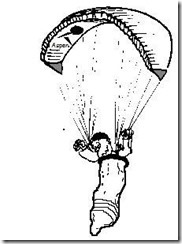PSC Safety Bulletin
May 2019 Some thoughts from my recent SIV course. And other thoughts
This was my third SIV course; I still learned loads, and discovered how much more I don’t know. Top tip: buy a cheap Chinese radio and headset (other Nationalities are available)that you won’t care too much about getting wet. Trying to listen to a radio speaker, inside a waterproof case, while the world is going nuts around you is almost impossible. The wind noise from some of the manoeuvres wipes out everything.
Wingovers. These are more complex than they look – done well they are a delight: that feeling of body and glider in perfect harmony carving accurate, graceful arcs through the sky. Done badly, they have the potential to bite hard, and are more difficult than they look. So, please take care trying them out over land or near the terrain. We’ve had members seriously hurt doing wingovers and SATs close to the hill – you need loads of clearance horizontally and vertically, to give enough time to sort thigs out if you get it wrong. This is not the place to talk about how they’re done (and I’m not the person to do that, either), but make sure you learn progressively, in the right environment, with sound guidance.
The guidance and supervision are so important. Someone trying tumbles in Olu Deniz fell into his wing and hit the water. While there will have been some drag from the trailing fabric, he must have reached a big percentage of human terminal velocity. Sadly, he did not survive. I never found out if he was under any form of instruction but given the poor entry into his manoeuvre, I doubt it – any instructor would have been screaming at him to stop after the first loop, which clearly lacked enough energy. Water does not guarantee a soft landing.
In the papers, there are reports of a paraglider pilot airlifted to hospital from Pendle last Sunday (19th May). The Air Accident Investigation Bureau have informed the BHPA; so far the victim is unidentified, and there are conflicting reports about the severity of his (her?) injuries. Perhaps it wasn’t one of our members, but if he/she was BHPA there is a legal duty to submit an incident report. If you have any knowledge of the incident, then please complete the online report form (https://contact.bhpa.co.uk/incident.php). Every bit of data regarding flight incidents helps to build a fuller picture of the hazards we all face.
NOTAMs. Are we all checking these carefully before picking our site and/or route? https://notaminfo.com/ is easy to use and you can set your own preferences for which areas of the country and type of NOTAM you want to see displayed. If, like me, you see very few NOTAMs on the map, have a look at your local settings – mine had somehow changed to exclude the western half of the country.
CANP. Midweek flying is likely to bring you into conflict with the military, especially in training hotspots like the Dales, Lake District and Yorkshire. It’s far from perfect, as there is little scope for XC flying, but it’s easy to use and could be a life-saver. http://www.bhpa.co.uk/documents/safety/canp/
Brian
